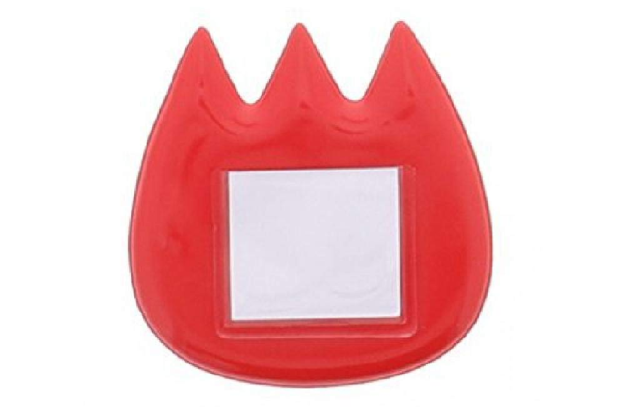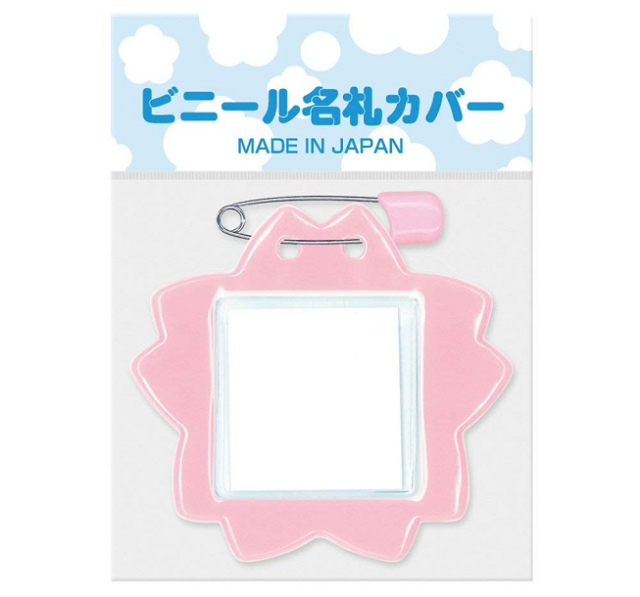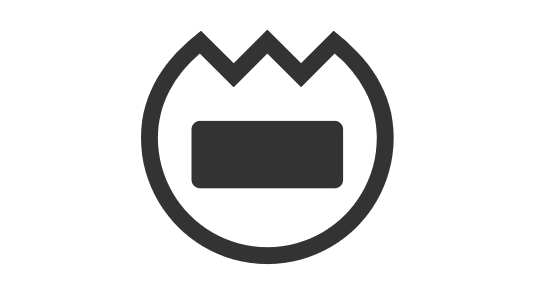
It’s not fire, and it’s not food, but every Japanese person immediately understands the symbol that has the rest of the world scratching their heads.
One of the amazing things about language is how it entirely changes the way you interpret visual symbols. For example, to anyone who reads Japanese, ッ is just how you write the sound “tsu,” but to many people overseas, it looks more like a pair of eyes and an extra-large smile/smirk.
But while switching over to actual, intentional illustrations eliminates the language barrier, it doesn’t erase cultural differences, which brings us to this.
If you’ve dug deep into the emoji options on your smartphone or other device, you might have come across this symbol and wondered just what it’s supposed to be. You could argue it looks sort of like someone ignored a “do not enter” road sign and smashed the top portion of it by ramming it with their car, but the most common interpretation among English-speaking Internet users seems to be that it’s a picture of a block of tofu in the middle of a roaring fire.
Much like the word emoji itself, the 📛 emoji has its roots in Japan. However, flambéed tofu isn’t a traditional Japanese dish, and the symbol actually represents something entirely different. It’s a drawing of a tulip-shaped nafuda, or name badge, like the ones commonly worn by Japanese preschoolers, with a white space in which to write the child’s name. So no, 📛 isn’t a burning tofu picture used when you’re hungry but going vegetarian for the day. It’s used when you’re talking about preschools, your young kids, and other early childhood topics.
▼ Though the one most frequently seen in emoji sets is fire-red, the badges can actually be purchased in all sorts of different colors.
Name badge 📛 (not tofu on fire) pic.twitter.com/IOCpyP6QiB
— Mariko Kosaka (@kosamari) April 1, 2017
Okay, so that covers the “what,” but what about the “why?” That’s a little trickier, as even in Japan, no one seems to be quite sure why tulips are so strongly associated with preschools, aside from the simple fact that they look cute. Some theorize it’s because tulips are fast-growing flowers, making them an auspicious symbol for kids taking the first steps of their academic and social lives, while others think the reason might have something to do with the “Tulip Song,” a popular nursery school singalong in Japan.
▼ Performed here by two singers wearing stylized versions of the standard Japanese preschool smock, but, ironically, not wearing tulip name badges.
▼ Making tulip name badge origami is also a quick and easy arts and crafts project.
チューリップはまった。
— S e r i n a . (@serish11) July 1, 2015
明日の折り紙テストやり方見んでも出来そう。ってくらい折った。楽しい。 pic.twitter.com/lsZ6lbSJ3u
Tulip-shaped badges may be the first ones that spring to mind for many Japanese people, but not every preschool in the country uses them. Some, for example, have the kids wear badges that look like sunflowers or cherry blossoms, like the one below.
Flower-shaped name badges can easily be found in Japanese craft and discount stores, and are also sold online through Amazon Japan (the tulip and sakura versions above sell for 270 yen [US$2.40] and 90 yen, respectively). Oh, and if your PC or device supports Japanese text input, you can also conjure one up by typing “nafuda” then cycling through the rendering choices.
Because really, Japanese word processing programs are absolutely filled with cool artwork.
Sources: Twitter/@nijieith via Hachima Kiko, Hatena
Top image: Amazon Japan/ベルハウス
Insert images: SoraNews24, Amazon Japan/栄プラスチック, SoraNews24
Follow Casey on Twitter, where he’s currently digesting a lunch of mabo tofu.




 For the not-so-low cost of US$1,300 you can own almost every Pretty Cure collector’s badge set
For the not-so-low cost of US$1,300 you can own almost every Pretty Cure collector’s badge set Japan’s anti-train groper badge design contest announces this year’s winners
Japan’s anti-train groper badge design contest announces this year’s winners Japan’s 10 favorite emoji for Twitter, and how they compare to the rest of the world
Japan’s 10 favorite emoji for Twitter, and how they compare to the rest of the world Japanese city cuts 800,000 tulips after people refuse to stay away despite coronavirus risks
Japanese city cuts 800,000 tulips after people refuse to stay away despite coronavirus risks The emoji you send actually say a lot about you
The emoji you send actually say a lot about you Non-tourist trap fish market in northeastern Japan captures our hearts with amazing sashimi
Non-tourist trap fish market in northeastern Japan captures our hearts with amazing sashimi Kyoto becomes City of Yokai, with Night Parade of One Hundred Demons festival this autumn
Kyoto becomes City of Yokai, with Night Parade of One Hundred Demons festival this autumn Japan’s newest life-size Gundam is finished, receives Shinto blessing in Osaka【Video】
Japan’s newest life-size Gundam is finished, receives Shinto blessing in Osaka【Video】 Chinese drivers flocking to Japan for quick and easy route to international licenses
Chinese drivers flocking to Japan for quick and easy route to international licenses One of Japan’s most awesome rail passes, the Seishun 18 Ticket, just got a lot less awesome
One of Japan’s most awesome rail passes, the Seishun 18 Ticket, just got a lot less awesome No train, no hotel – How to do an overnight bus trip to Kanazawa from Tokyo – Part 1【Photos】
No train, no hotel – How to do an overnight bus trip to Kanazawa from Tokyo – Part 1【Photos】 McDonald’s Japan debuts new anime girl mascot character with incredibly long name
McDonald’s Japan debuts new anime girl mascot character with incredibly long name Korean basketball coach humiliates player live on TV, tapes his mouth shut
Korean basketball coach humiliates player live on TV, tapes his mouth shut We try a delicious hidden gem in Fukuoka, unknown to even Japanese people
We try a delicious hidden gem in Fukuoka, unknown to even Japanese people Studio Ghibli releases new “Butterflies in the Forest” Totoro towels
Studio Ghibli releases new “Butterflies in the Forest” Totoro towels What’s the deal with akebi, the perfectly purple, alien-like fruit that’s in season now in Japan?
What’s the deal with akebi, the perfectly purple, alien-like fruit that’s in season now in Japan? Totoro, Calcifer, other Ghibli stars returning as humidifiers ahead of Japan’s dry winter days【Pics】
Totoro, Calcifer, other Ghibli stars returning as humidifiers ahead of Japan’s dry winter days【Pics】 Is downtown Tokyo’s crazy cheap 290-yen bento boxed lunch shop still around, and is it still cheap?
Is downtown Tokyo’s crazy cheap 290-yen bento boxed lunch shop still around, and is it still cheap? Meet the kind Japanese grandpa who takes photos for tourists at the Hachiko statue in Shibuya
Meet the kind Japanese grandpa who takes photos for tourists at the Hachiko statue in Shibuya Studio Ghibli releases new mug tumblers featuring anime movie characters
Studio Ghibli releases new mug tumblers featuring anime movie characters How to power up the coolest cheap souvenir from Nintendo’s official shop with a trip to Daiso
How to power up the coolest cheap souvenir from Nintendo’s official shop with a trip to Daiso Why was the Lithuanian ambassador to Japan working in a fast food beef bowl joint in Tokyo?
Why was the Lithuanian ambassador to Japan working in a fast food beef bowl joint in Tokyo? Line of foreign tourists leads us to Akihabara’s meatiest fatty ramen【Taste test】
Line of foreign tourists leads us to Akihabara’s meatiest fatty ramen【Taste test】 Japanese convenience store Family Mart announces abolishment of eat-in spaces
Japanese convenience store Family Mart announces abolishment of eat-in spaces Studio Ghibli releases new insect whistle necklace from Nausicaä of the Valley of the Wind
Studio Ghibli releases new insect whistle necklace from Nausicaä of the Valley of the Wind Totoro sequel anime Mei and the Baby Catbus will screen at Ghibli Park this winter
Totoro sequel anime Mei and the Baby Catbus will screen at Ghibli Park this winter Starbucks Japan unveils Halloween Frappuccino for 2024, and it’s like drinking a magic spell
Starbucks Japan unveils Halloween Frappuccino for 2024, and it’s like drinking a magic spell Evangelion creator Hideaki Anno returning to anime with new project for 50-year-old franchise
Evangelion creator Hideaki Anno returning to anime with new project for 50-year-old franchise Studio Ghibli releases new Howl’s Moving Castle goods that capture the magic from the anime movie
Studio Ghibli releases new Howl’s Moving Castle goods that capture the magic from the anime movie Adult Jam Bread causes a stir at store in Tokyo
Adult Jam Bread causes a stir at store in Tokyo Right now is the peak time to go to Tokyo’s most-beautiful-view beer garden【Photos】
Right now is the peak time to go to Tokyo’s most-beautiful-view beer garden【Photos】 Pizza Hut adds a “Guilty Secret” sandwich to its menu for a limited time
Pizza Hut adds a “Guilty Secret” sandwich to its menu for a limited time McDonald’s new Happy Meals offer up cute and practical Sanrio lifestyle goods
McDonald’s new Happy Meals offer up cute and practical Sanrio lifestyle goods Foreign tourists on Shinkansen bullet train break suitcase etiquette, angering local passengers
Foreign tourists on Shinkansen bullet train break suitcase etiquette, angering local passengers [Deleted] Article written for April Fool’s Day 2018
[Deleted] Article written for April Fool’s Day 2018 Japanese government to make first change to romanization spelling rules since the 1950s
Japanese government to make first change to romanization spelling rules since the 1950s Foreigner’s request for help in Tokyo makes us sad for the state of society
Foreigner’s request for help in Tokyo makes us sad for the state of society Ghibli founders Toshio Suzuki and Hayao Miyazaki contribute to Japanese whisky Totoro label design
Ghibli founders Toshio Suzuki and Hayao Miyazaki contribute to Japanese whisky Totoro label design Tokyo’s most famous Starbucks is closed
Tokyo’s most famous Starbucks is closed Princesses, fruits, and blacksmiths: Study reveals the 30 most unusual family names in Japan
Princesses, fruits, and blacksmiths: Study reveals the 30 most unusual family names in Japan Doraemon found buried at sea as scene from 1993 anime becomes real life【Photos】
Doraemon found buried at sea as scene from 1993 anime becomes real life【Photos】 Japanese company uses video game-style hit point badges to help employees know who needs a hand
Japanese company uses video game-style hit point badges to help employees know who needs a hand Japan would like to remind you that “emoji” has nothing to do with “emotion”
Japan would like to remind you that “emoji” has nothing to do with “emotion” Distressed moms and dads on Japanese trains getting help from child assistance volunteer badges
Distressed moms and dads on Japanese trains getting help from child assistance volunteer badges Cardcaptor Sakura gets a special limited-time Twitter emoji to celebrate cherry blossom season
Cardcaptor Sakura gets a special limited-time Twitter emoji to celebrate cherry blossom season Stay home in style with Kyoto-easy hakama-inspired roomwear for men, women, and kids【Photos】
Stay home in style with Kyoto-easy hakama-inspired roomwear for men, women, and kids【Photos】 Poo emoji hand signals go viral on Japanese Twitter
Poo emoji hand signals go viral on Japanese Twitter Koka City’s municipal workers transform yet again into ninja for Ninja Day【Video】
Koka City’s municipal workers transform yet again into ninja for Ninja Day【Video】 Taiwanese artist’s pencil tip sculptures are miniature masterpieces 【Pics】
Taiwanese artist’s pencil tip sculptures are miniature masterpieces 【Pics】 Japanese survey finds top 10 emoji that “make you look like an old man”
Japanese survey finds top 10 emoji that “make you look like an old man” Newest Japanese Twitter craze has users guessing movies using only emoji as hints
Newest Japanese Twitter craze has users guessing movies using only emoji as hints Japanese woman wants office romance but has no job, figures out how to make her dream come true
Japanese woman wants office romance but has no job, figures out how to make her dream come true Complaints lead to talks about whether noise from schools should be regulated
Complaints lead to talks about whether noise from schools should be regulated What’s inside the Disney Store’s 10,000-yen Lucky Box? This year, actually useful items!
What’s inside the Disney Store’s 10,000-yen Lucky Box? This year, actually useful items! Tokyo Comic-Con reverses policy, will allow male cosplayers to dress as female characters
Tokyo Comic-Con reverses policy, will allow male cosplayers to dress as female characters Show off your badge collection and plushies in this wacky customisable sweater from Japan
Show off your badge collection and plushies in this wacky customisable sweater from Japan AKB48, Love Live! idol supergroups to perform live in Los Angeles this summer
AKB48, Love Live! idol supergroups to perform live in Los Angeles this summer
Leave a Reply